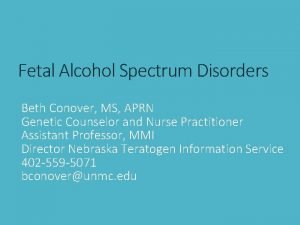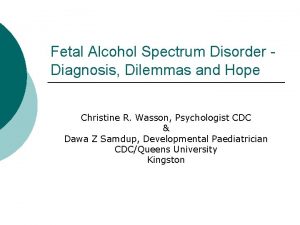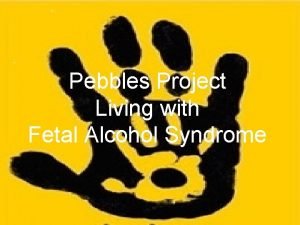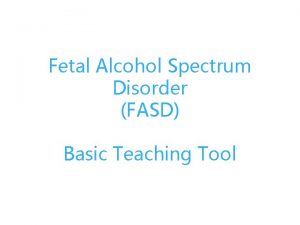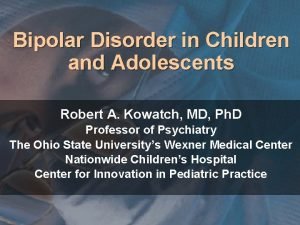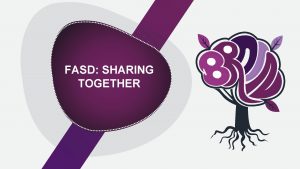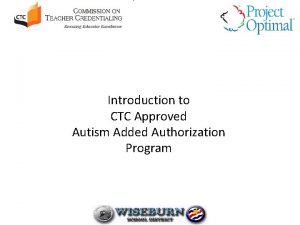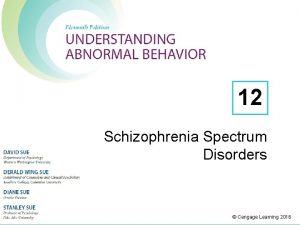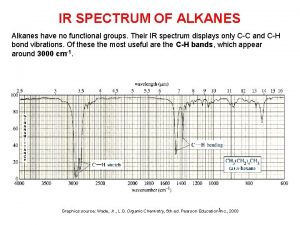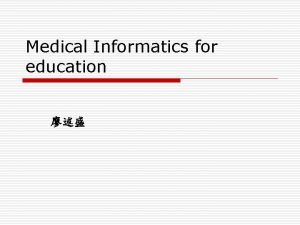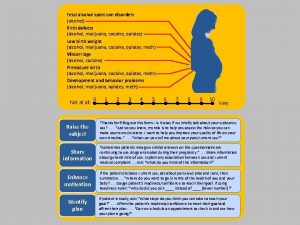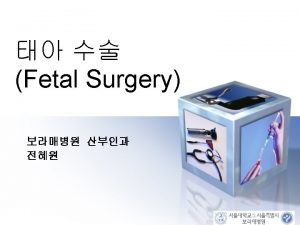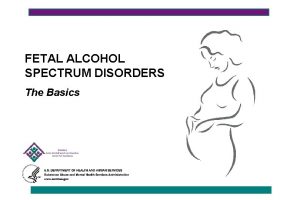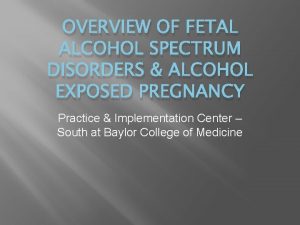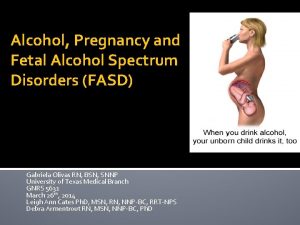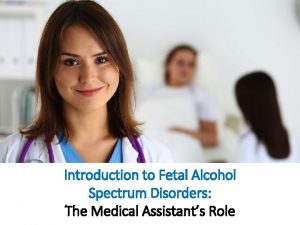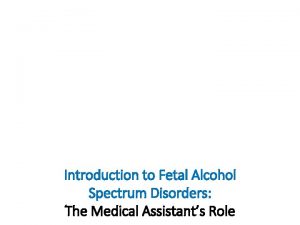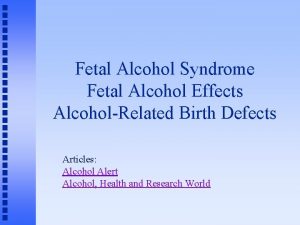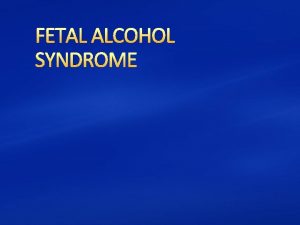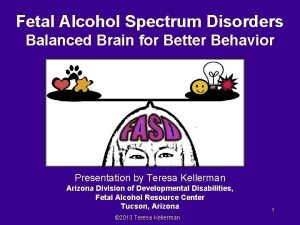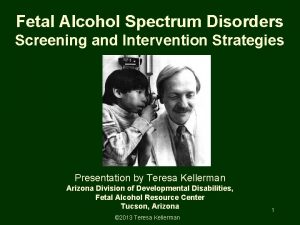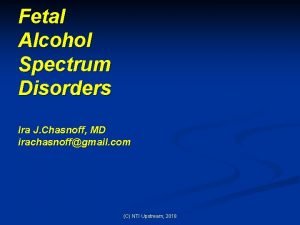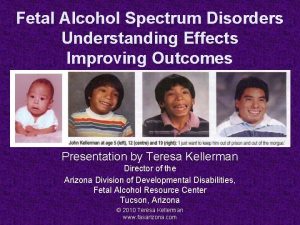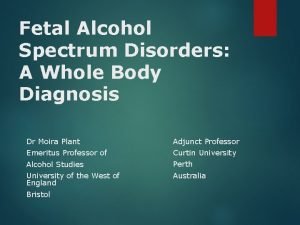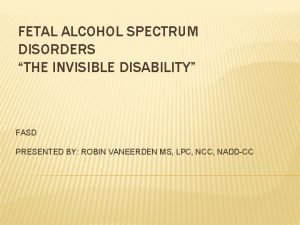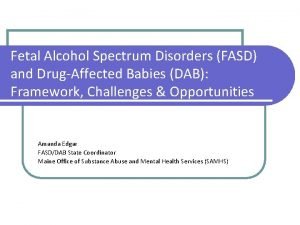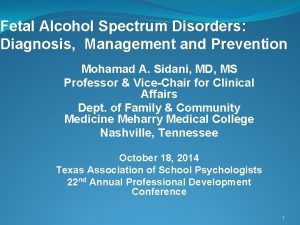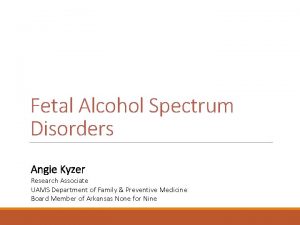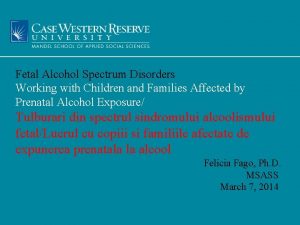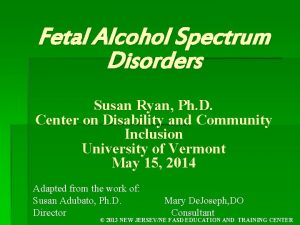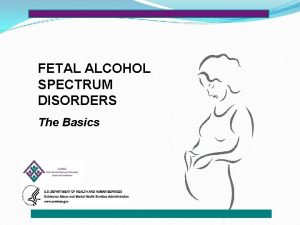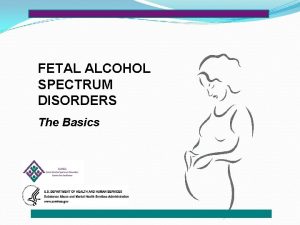Introduction to Fetal Alcohol Spectrum Disorders The Medical


































































- Slides: 66

Introduction to Fetal Alcohol Spectrum Disorders: The Medical Assistant’s Role

Funding for this presentation was made possible by the Centers for Disease Control and Prevention. The views expressed in written materials and by speakers do not necessarily reflect the official policies of the Department of Health and Human Services, nor does the mention of trade names, commercial practices, or organizations imply endorsement by the U. S. Government.

OVERALL LEARNING OBJECTIVES By the end of this training, you will be able to: 1 Discuss the lifelong effects of FASDs. Become familiar with how FASDs are diagnosed and 2 why early intervention is important. Describe screening techniques used to determine who 3 is at risk for an alcohol-exposed pregnancy. Identify ways to improve communication with patients 4 about their alcohol use.

The MA Scope of Work Always refer to your state and/or employer's scope of practice regulations for the role of the MA.

SECTION 1 The lifelong effects of FASDs

Fetal Alcohol Spectrum Disorders (FASDs) • a continuum of disorders ranging from mild intellectual & behavioral issues to extreme issues that may lead to profound disabilities or premature death • caused solely by prenatal alcohol exposure and are NOT hereditary • last a lifetime, but there are benefits from early diagnosis, support, & services (NCBDDD, 2015 b)

F A S D not a clinical diagnosis Not all prenatal alcohol-related conditions show the identifying physical characteristics (Bertrand et al. , 2004)

FASDs are COMPLETELY PREVENTABLE with NO ALCOHOL USE DURING PREGNANCY

10. 2% of pregnant women aged 18 to 44 years report current alcohol use (CDC, 2015 a)

ALCOHOL IS A TERATOGEN (a substance that causes malformation to the developing baby) (Bertrand et al. , 2004)

The impact of alcohol on the developing baby is NOT reversible.

(Coles, 1994) (CDC, 2015 b)

The prevalence of FASDs in the United States is estimated to be as high as 2 -5% of school-age children, a rate similar to that of autism spectrum disorders. (May et al. , 2014; Astley et al. , 2002; Fast et al. , 1999)


Living with FASDs Video (NOFAS, 2012 b)

SECTION 2 Diagnostic resources for FASDs

3 characteristics associated with prenatal alcohol exposure 1. Specific facial features 2. Growth deficiency 3. Central nervous system problems

small palpebral fissures 1. Specific Facial Features (Dysmorphia) (Astley & Clarren, 2001; Bertrand et al. , 2004)

2. Growth Problems 2. Growth deficiency Photo Source: http: //pubs. niaaa. nih. gov/publications/social/Module 10 KFeta. Exposure/Module 10 K. html Chart Source: http: //www. cdc. gov/growthcharts/clinical_charts. htm (CDC, 2001; Module 10 K: Fetal Alcohol Exposure, n. d. )

(NCBDDD, 2014 c)

Non-alcohol affected vs. Profoundly alcohol-affected brain (Streissguth & Little, 1994)

Co-Occurring Behavioral/Mental Health Issues • Anxiety and mood disorders, particularly depression • Attention-deficit/hyperactivity disorder • Substance use • Trouble with the law • High risk sex behaviors and sexual abuse • Homelessness or transiency (Streissguth et al. , 1996; Williams & Smith, 2015)

5 types of concerns that may lead to an assessment for an FASD 1. Developmental or behavioral concerns 2. Dysmorphic facial features associated with prenatal alcohol exposure (PAE) 3. Growth deficiency at or below 10 th percentile for head circumference, height, weight at any time, including prenatally 4. History of confirmed or suspected PAE 5. Self-reported or family concern about possible FASD (AAP, 2016)

Importance of early identification • Early identification, before six years of age when possible, helps reduce risk of later life problems. • Early diagnosis works by helping families affected by FASDs to get the support and services they need which can include counseling, medical specialty care, peer and community programs. (Streissguth, 1997; Williams & Smith, 2015)

SECTION 3 Screening techniques to determine who is at risk for an alcohol-exposed pregnancy

(CDC, n. d. )

What Is Considered A Standard Drink? (NIAAA, 2005, n. d. b)

Guidelines on alcohol use during pregnancy are clear

The 2005 U. S. Surgeon General Advisory stressed that • A woman should not drink any alcohol during pregnancy. • A pregnant woman who has already consumed alcohol during her pregnancy should stop in order to minimize further risk. • A woman who is considering becoming pregnant should abstain from alcohol. (U. S. Department of Health and Human Services, 2005)

American College of OB-GYNs American Academy of Pediatrics Centers for Disease Control and Prevention NO alcohol use during pregnancy OR while trying to conceive (ACOG, 2008; AAP, 2015 a; NCBDDD, 2014 b)

2 ways to prevent alcohol exposed pregnancies 1. Reduce risky drinking 2. Use birth control effectively Optimal outcome – Women choose to do both. (Balachova et al. , 2013; Floyd et al. , 2007; Wilton, et al. , 2013)

Alcohol Screening and Brief Intervention (a. SBI)


SCREEN ALL WOMEN OF CHILDBEARING AGE

Simple Screening Questions ü Non-Pregnant: “On any single occasion during the past 3 months, have you had more than 3 drinks containing alcohol? ” ü Pregnant: “Have you had a drink since you found out you were pregnant? ” If the response to this one question is “yes”, follow clinic protocol such as using another set of screening questions or deferring to the healthcare provider. (CDC, 2014 a)


Examples of Brief Interventions • Advise a woman who drinks moderately and is pregnant or who is contemplating a pregnancy to abstain from alcohol in order to prevent an FASD • Help a woman weigh the costs/benefits of reducing alcohol use before or during pregnancy • Help a woman maintain motivation to reduce/eliminate drinking by reinforcing the benefits of an alcohol-free pregnancy

SECTION 4 Improve communication with patients about alcohol use and pregnancy

The highest alcohol use during pregnancy is among … ? ? ?

Women Aged 35 -44 years (18. 6%) (CDC, 2015 a)

College graduates (13. 0%) (CDC, 2015 a)

If medical professionals ASSUME certain populations are less likely to engage in risky drinking, OPPORTUNITIES for screening, identification of risky use, and prevention of FASDs may be LOST.

Stigma Prevents Healthcare Providers from Asking about Alcohol • Many myths and biases towards people with alcohol and substance use disorders (AUDs/SUDs) • Women with AUDs/SUDs are often stereotyped • Many healthcare professionals do not receive comprehensive education about AUDs/SUDs

Stigma is a barrier to diagnosing FASDs • Stigma can prevent concerned parents from discussing their alcohol use during pregnancy • Providers may fear that diagnosing a child or adult with an FASD will be “labeling” them with a stigmatizing condition (Van Boekel et al. , 2013; Rojmahamongkol et al. , 2015; NOFAS, n. d. )

no woman drinks because she wants to hurt her baby

Role of the MA • Avoid assumptions and biases about who is at risk for an alcohol-exposed pregnancy • Ask at EVERY visit – Screening for alcohol misuse can be as common as a blood pressure • Have resources available to help women that need support to stop drinking • Have culturally relevant material available for families

Words can perpetuate STIGMA • Avoid blaming language ‒ FASD occurs when a fetus is exposed to alcohol NOT FASD occurs when a pregnant woman drinks ‒ A child who has an FASD versus an FASD child (person first language)

Melissa: Birth mother of a child with FASD (NOFAS, 2012 a)


F A S D

Alcohol affects multiple organ systems throughout pregnancy, particularly the baby’s brain.

NO SAFE TIME NO SAFE TYPE NO KNOWN SAFE AMOUNT


SCREEN ALL WOMEN OF CHILDBEARING AGE


Thank you!!

Patient Question: I just found out I am pregnant. I have stopped drinking, but was drinking in the first few weeks of my pregnancy, before I knew I was pregnant. What should I do now?

Answer: • The most important thing is that you have completely stopped drinking since learning of your pregnancy. • It is never too late to stop drinking. • Because brain growth takes place throughout pregnancy, the sooner you stop the safer it will be for you and your baby. • Talk with your health care provider as soon as possible and share your concerns. Make sure you get regular prenatal checkups. (NCBDDD, 2014 a)

Patient Question: I drank wine during my last pregnancy and my baby turned out fine. Why shouldn't I drink again during this pregnancy?

Answer: • Every pregnancy is different. • Drinking alcohol might affect one baby more than another. • You could have one child who is born healthy and another child who is born with problems. • Sometimes, alcohol-related effects don’t appear until later in life, so if you drank during your first pregnancy, you should speak with your child’s healthcare provider. (NCBDDD, 2014 a)

Patient Question: I suspect my child might have an FASD. What should I do?

Answer: • If you think your child might have an FASD, talk to your child's doctor and share your concerns. Don't wait. • If a problem is suspected, ask the doctor for a referral to a specialist who knows about FASDs, such as a developmental pediatrician, child psychologist, or clinical geneticist. • To find doctors and clinics in your area, visit the National and State Resource Directory from the National Organization on Fetal Alcohol Syndrome (NOFAS). • Also call your state’s public early childhood system to request a free evaluation to find out if your child qualifies for intervention services. This is sometimes called a Child Find evaluation. You do not need to wait for a doctor’s referral or a medical diagnosis to make this call. (NCBDDD, 2014 a)

Patient Question: Why should I worry about alcohol use if I am not pregnant and not trying to get pregnant.

Answer: • Nearly half of all pregnancies in the United States are unplanned. • If you drink alcohol and do not use contraception (birth control) when you have sex, you might get pregnant and expose your baby to alcohol before you know you are pregnant. • So, if you are not trying to get pregnant but you are having sex, talk to your health care provider about using contraception consistently. (NCBDDD, 2014 a)

Patient Question: Why are you asking about my alcohol use?

Answer: • We ask every patient about their alcohol use. • Just like knowing your blood pressure can help with making decisions about your care, knowing your drinking levels can also help us provide you with better care. • It is important when caring for women of childbearing age to assess their alcohol consumption as this is a key time to prevent alcohol exposed pregnancy. (NCBDDD, 2014 a)
 Fetal alcohol spectrum disorder
Fetal alcohol spectrum disorder Popstrus
Popstrus Fasd
Fasd Life expectancy of someone with fetal alcohol syndrome
Life expectancy of someone with fetal alcohol syndrome Fas
Fas Fetal alcohol syndrome face
Fetal alcohol syndrome face Fetal alcohol syndrome life expectancy
Fetal alcohol syndrome life expectancy Fetal alcohol syndrome
Fetal alcohol syndrome Fetal alcohol syndrome
Fetal alcohol syndrome Puberty and autism spectrum disorders
Puberty and autism spectrum disorders Autism spectrum disorders added authorization
Autism spectrum disorders added authorization Chapter 12 schizophrenia spectrum disorders
Chapter 12 schizophrenia spectrum disorders Chapter 12 schizophrenia spectrum disorders
Chapter 12 schizophrenia spectrum disorders High boiling point alcohols
High boiling point alcohols Oxidation of tertiary alcohol
Oxidation of tertiary alcohol Thomson higher education
Thomson higher education Orbital description
Orbital description Absorption spectrum
Absorption spectrum Hát kết hợp bộ gõ cơ thể
Hát kết hợp bộ gõ cơ thể Slidetodoc
Slidetodoc Bổ thể
Bổ thể Tỉ lệ cơ thể trẻ em
Tỉ lệ cơ thể trẻ em Chó sói
Chó sói Thang điểm glasgow
Thang điểm glasgow Bài hát chúa yêu trần thế alleluia
Bài hát chúa yêu trần thế alleluia Các môn thể thao bắt đầu bằng tiếng nhảy
Các môn thể thao bắt đầu bằng tiếng nhảy Thế nào là hệ số cao nhất
Thế nào là hệ số cao nhất Các châu lục và đại dương trên thế giới
Các châu lục và đại dương trên thế giới Công thức tính thế năng
Công thức tính thế năng Trời xanh đây là của chúng ta thể thơ
Trời xanh đây là của chúng ta thể thơ Cách giải mật thư tọa độ
Cách giải mật thư tọa độ Phép trừ bù
Phép trừ bù độ dài liên kết
độ dài liên kết Các châu lục và đại dương trên thế giới
Các châu lục và đại dương trên thế giới Thể thơ truyền thống
Thể thơ truyền thống Quá trình desamine hóa có thể tạo ra
Quá trình desamine hóa có thể tạo ra Một số thể thơ truyền thống
Một số thể thơ truyền thống Bàn tay mà dây bẩn
Bàn tay mà dây bẩn Vẽ hình chiếu vuông góc của vật thể sau
Vẽ hình chiếu vuông góc của vật thể sau Nguyên nhân của sự mỏi cơ sinh 8
Nguyên nhân của sự mỏi cơ sinh 8 đặc điểm cơ thể của người tối cổ
đặc điểm cơ thể của người tối cổ V. c c
V. c c Vẽ hình chiếu đứng bằng cạnh của vật thể
Vẽ hình chiếu đứng bằng cạnh của vật thể Vẽ hình chiếu vuông góc của vật thể sau
Vẽ hình chiếu vuông góc của vật thể sau Thẻ vin
Thẻ vin đại từ thay thế
đại từ thay thế điện thế nghỉ
điện thế nghỉ Tư thế ngồi viết
Tư thế ngồi viết Diễn thế sinh thái là
Diễn thế sinh thái là Các loại đột biến cấu trúc nhiễm sắc thể
Các loại đột biến cấu trúc nhiễm sắc thể Số nguyên tố là gì
Số nguyên tố là gì Tư thế ngồi viết
Tư thế ngồi viết Lời thề hippocrates
Lời thề hippocrates Thiếu nhi thế giới liên hoan
Thiếu nhi thế giới liên hoan ưu thế lai là gì
ưu thế lai là gì Khi nào hổ mẹ dạy hổ con săn mồi
Khi nào hổ mẹ dạy hổ con săn mồi Sự nuôi và dạy con của hươu
Sự nuôi và dạy con của hươu Sơ đồ cơ thể người
Sơ đồ cơ thể người Từ ngữ thể hiện lòng nhân hậu
Từ ngữ thể hiện lòng nhân hậu Thế nào là mạng điện lắp đặt kiểu nổi
Thế nào là mạng điện lắp đặt kiểu nổi California medical license for foreign medical graduates
California medical license for foreign medical graduates Greater baltimore medical center medical records
Greater baltimore medical center medical records Difference between medical report and medical certificate
Difference between medical report and medical certificate Torrance memorial hospital medical records
Torrance memorial hospital medical records Cartersville medical center medical records
Cartersville medical center medical records Introduction to medical informatics
Introduction to medical informatics Medical terminology chapter 1 answer key
Medical terminology chapter 1 answer key


